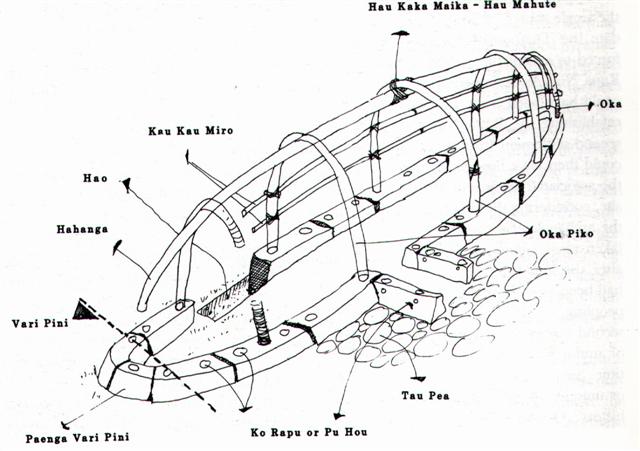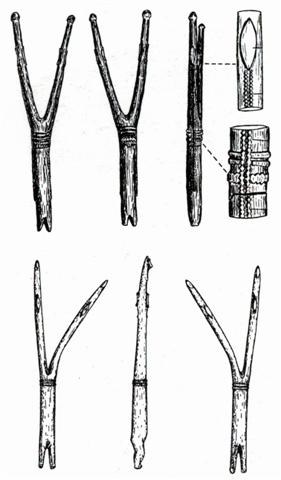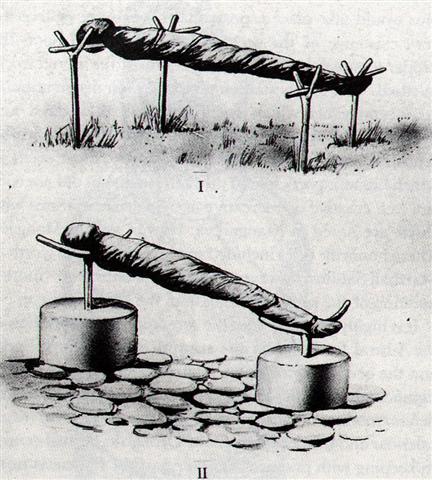|
TRANSLATIONS
Next pages:
|
3.
With the sun child arriving in a canoe after winter solstice,
intending to rule the first half of the year, the overturned
canoe in form of
hare paega on Easter Island surely must be in
the image of the second half of the year:

From its
dark inside, at winter solstice, the newborn child will come out.
The calendar of the night in Tahua could allude to this
event:
 |
 |
 |
 |
|
Aa1-42 |
Aa1-43 |
Aa1-44 |
Aa1-45 |
The
entrance is also the exit, presumably the midnight glyph Aa1-43. The
sun child is in his canoe (Aa1-45). The two great toa (Aa1-42
and Aa1-44) are like Oka Piko. The fork (Y-sign) in toa
glyphs may have been named okaoka:
|
Oka
1. Lever, pole; to dig holes in the
ground with a sharpened stick, as was done in ancient
times to plant vegetables; used generally in the meaning
of making plantations. 2. The four sideways poles
supporting a hare paega. Okaoka, to jab,
to pierce, to prick repeatedly. Vanaga.
Digging stick, stake, joist; to prick,
to pierce, to stick a thing into, to drive into, to
slaughter, to assassinate; kona oka kai,
plantation; pahu oka, a drawer. Okaoka, a
fork, to prick, to dig. Okahia, to prick.
Churchill. |
|
|
4.
The canoe should, however, contain two children,
twins,
because one (the divine child) will take charge of the 1st half
of the year while the second (the mortal child) will rule the
2nd half. Life returns with the sun child. It is proven by the leaves and
other greenery starting to grow. When the mortal child begins his
rule, though, the world turns into straw again.
The double-canoe, with two hulls, beautifully depicts the twins.
In the night calendars of H, P, and Q we can see two hulls:
 |
 |
 |
 |
|
Ha5-43 |
Ha5-44 |
Ha5-45 |
Ha5-46 |
 |
 |
 |
 |
 |
|
Pa5-25 |
Pa5-26 |
Pa5-27 |
Pa5-28 |
Pa5-29 |
 |
 |
 |
 |
 |
|
Qa5-33 |
Qa5-34 |
Qa5-35 |
Qa5-36 |
Qa5-37 |
Each of the
twins here has a separate hull. |
In other words, the twins are
formed in two separate eggs.
|
5.
The door of entrance into this world is also the door of
exit. Spatially seen they are different though, with birth
occurring in the east and death in the west. Temporally they are
connected because the life of children depends on the death of
their parents - Ulu gave his life to Mokuola. With twin children there should be
twin parents,
which correspond to the 1st (divine) and 2nd (mortal) toa
glyphs around the midnight henua:
 |
 |
 |
|
Aa1-42 |
Aa1-43 |
Aa1-44 |
| e ia toa tauuruuru |
raaraa |
e ia toa tauuru |
Metoro
regarded them as being different. We should notice that Hawaiian
ulu corresponds to Easter Island uru.
The Y-sign can now be understood as referring to the dead twin
parents. From them new twigs will sprout:

"For the best-documented
esoteric meaning of the Y-shape we must look to Mangareva, where
'forked stick' wands and 'stick man' effigies called eketea
were used in mortuary, fertility and initiation rituals conducted by
priests (taura) at which rogorogo and wood craftsmen
participated.
These interesting objects
were highly abstract depictions of the human form which had legs and
feet indicated and carved decorative bands around the midpoint. One
example has oval 'eyes' carved on each of the two parallel parts
forming the upright forks.
In Mangaia, the forms of
the 'forked sticks' erected on marae during the initiation of
the Temporal Lord are not known. It is very clear however, that
erecting these 'forked sticks' represented the visible commitment of
the individual district chiefs to act as toko (prop or
support) to the Temporal Lord as he undertook his duties." (Van
Tilburg) |
The Temporal Lord is not the
eternal one in the sky. After the celestial canoe has been turned around at
midsummer it has become dark. The female night sky is now in command, while
down on earth the forked stick men are supporters of the king.
|
6.
To continue with the connection between dead persons and
the Y-sign, we should notice the form of the
biers on
which corpses were supported:

The pictures come from
Van Tilburg. The first variant above seems to be more practical than
the bottom one. But the bottom one is more in agreement with myth -
with twin rulers there should be twin supports (toko). |
|
7.
The divine twin will deliver the life-giving 'water' (vai-ora-a-Tane)
in spring, and maybe he is Tane. In the day calendar of Tahua we find glyphs which resemble
toa and tao, viz.
tapa mea:
From the dead (dry) shape of toa, via the canoe of promise
(tao) the red light of tapa mea will arrive.
... It
seems likely that Llew's mediaeval successor, Red Robin Hood, was also once
worshipped as a stag. His presence at the Abbot's Bromley Horn Dance would be
difficult to account for otherwise, and 'stag's horn' moss is sometimes called
'Robin Hood's Hatband'. In May, the stag puts on his red summer coat
...
The 'red summer coat' does not arrive immediately beyond winter
solstice (or midnight). Mea means red and tapa means
cloth. |
8.
There now only remains to account for Metoro's
choice of words, primarily why he said
tao
most of the time instead of the expected vaka (canoe). A
quick search for vaka shows only four instances, all of
which refer to the glyph type which I have labelled marama:
 |
 |
 |
 |
|
Ba1-11 |
Eb3-8 |
Eb3-10 |
Eb6-25 |
| kua tere te
vaka |
kua oo te tere o te
vaka - ko te maro o
te vaka |
tarai hia te vae o
te vaka |
e
vaka kagore te kai o
roto |
The meaning of tao is obviously connected with the
earth-oven (umu). A pregnant woman has children in her womb,
where the children are being 'baked'. Sun children need a redhot
oven:
|
Tao
1. To cook in an oven, to sacrifice. P Mgv., Mq.,
Ta.: tao, to cook in an oven. 2. To carry away. 3. Abscess,
bubo, scrofula, boil, gangrene, ulcer, inflammation, sore. Mgv.:
taotaovere, small red spots showing the approach of death. Mq.:
toopuku, toopuu, boil, wart, tumor. Ta.: taapu,
taapuu, scrofula on neck and chin. 4. Mgv.: a lance, spear.
Ta.: tao, id. Sa.: tao, id. Ma.: tao, id. 5.
Mgv.: taotaoama, a fish. Sa.: taotaoama, id. 6. Ta.:
taoa, property, possessions. Ma.: taonga, property,
treasure. Churchill.
Sa.: tao, to bake; taofono,
taona'i, to bake food the day before it is used; tau, the
leaves used to cover an oven. To.: tao, to cook food in a
oven, to bake. Fu.: ta˛, to put in an oven, to cook. Niuē:
tao, to bake. Uvea:
tao, to cook, to bake.
Ma., Rapanui: tao, to
bake or cook in a native oven, properly to steam, to boil with
steam. Ta.: tao, the
rocks and leaves with which a pig is covered when cooking; baked,
boiled, cooked. Mq., Mgv., Mg., Tongareva: tao,
to bake in an oven ... The word refers to the specific manner of
cookery which involves the pit oven. The suggestion in the Maori,
therefore, does not mean a different method; it is but an attempt
more precisely to describe the kitchen method, a very tasty cookery,
be it said. The suggestion of boiling is found only in Tahiti, yet
in his dictionary Bishop Jaussen does not record it under the word
bouillir; boiling was
little known to the Polynesians before the European introduction of
pottery and other fire-resisting utensils ... Churchill 2.
Kao-kao,
v. Haw., be red. Root and primary meaning obsolete in Haw. Sam.,
tao,
to bake. Marqu., tao,
bake, roast, sacrifice. Tah., tao,
baked, boiled, cooked. Greek, καιω,
Old Att. καω,
to light, kindle, burn, scorch. According to Liddell and Scott, Pott
refers καιω
to Sanskrit šush,
be dry, but Curtius rejects this. In Dravid. (Tamil)
kay,
to be hot, burn. Fornander. |
We notice that leaves are used for covering. The sacrifice (tao)
leaves (tau) on the oven will result in new leaves sprouting. |
|






